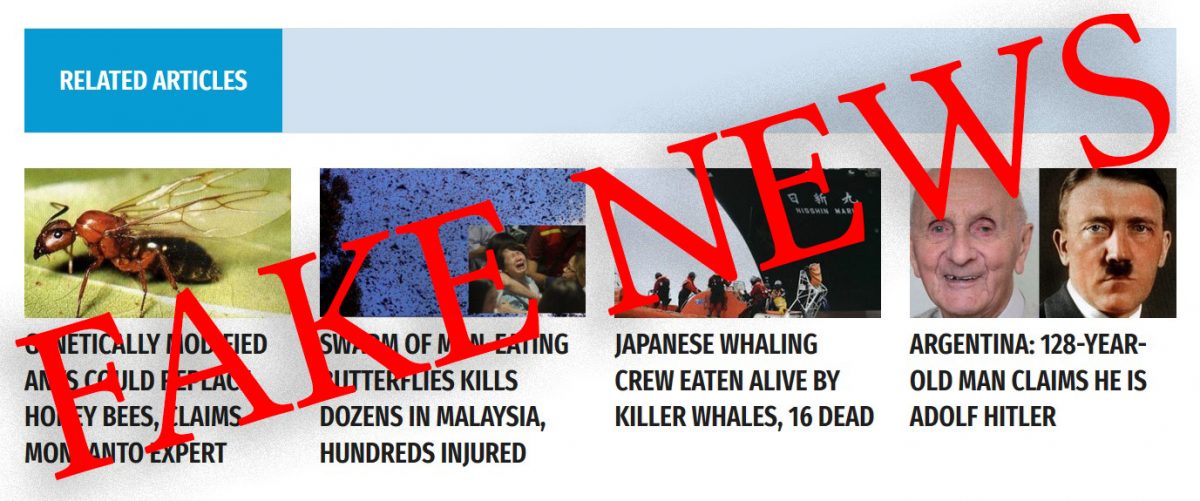
By John Lubbock, Communications Coordinator
I saw a friend on Facebook share an obvious piece of fake news a few days ago. It came from a site I’d seen before, World News Daily Report.
I looked at the Wikipedia page for the site, which said it was
“a fake news, satirical, purportedly American Jewish Zionist newspaper based in Tel Aviv, Israel,[1][disputed – discuss] dedicated to covering news and events from around the world in, by its own account, a completely ludicrous manner.[3]”
It also stated that the website’s owner was called Janick Murray-Hall, which it evidenced with a Buzzfeed article. Obviously the site’s own description of itself was a red herring, perhaps with some odd political or racist undertones.
‘Janick Murray-Hall runs World News Daily Report, a fake news site that scored five hits in the top 50 thanks to fake political headlines such as, “ISIS Leader Calls for American Muslim Voters to Support Hillary Clinton” and crime hoaxes like, “Morgue Worker Arrested After Giving Birth To A Dead Man’s Baby.”’
The top hit on Google when searching for Mr Murray-Hall is an article about another site he runs, the Journal de Mourréal, a site which attempts to look like and mock the real Journal de Montréal. This article mentions that Murray-Hall also uses the alias Bob Flanagan, a name so common that you won’t turn up anything particularly useful by searching for it.
Another article I discovered in French by a guy who has been investigating fake news interviewed Olivier Legault, a friend of Murray-Hall, and co-founder of JdM and WNDR. This provided another good reference to populate the WNDR Wikipedia page with.
The author of this article criticises Canadian ‘humorists’ who ‘were tearing their shirts to defend the Journal de Mourréal, their right to satire and, in a roundabout way, freedom of expression,[while] our two friends were busy polluting the English-language web with lies and hoaxes. Their other site is called the World News Daily Report (WNDR). There is no humor or satire here. This is pure false news, misinformation.’
The Radio Canada interviewer told Legault that he could not see the humour in the stories he made for WNDR. Legault’s response was vague and evasive.
‘”It depends … Sometimes, the idea is to think about an issue,” he says.
He hesitates a little.
“In a sense, there is a purpose in all this, to take self-criticism to people,” he finally said.’
When pressed that many people will not think hard enough to spot even obvious hoaxes, Legault says that if people want to believe something, it’s their fault essentially.
“The people who take it seriously are people who want to take it seriously. It’s stupid to say, but … We preach to converts. The majority of people who share it understand that it’s a joke, and others share it because they want to believe it, not because they really believe in it”.
Legault then admits that he finds it ‘a little disturbing’ how people will believe anything, saying:
“You can invent everything and anything and people will believe it. Honestly, it’s a little disturbing when you realise that. As long as you confirm what they want to believe, they will share it. If you go against their opinion, they will immediately think that this is false news. But if you go in the direction of their opinion, they will share it right away. They lose their critical spirit.”
One really big problem with exploiting people’s stereotypical or lazy assumptions is that many of them are based on racist, xenophobic or misogynistic ideas about the world. Looking on WNDR right now gives all manner of stories that might appeal to people’s bigoted beliefs about how the world works, like ‘FORMER ISIS SOLDIER EMASCULATED BY GOAT SEEKS REFUGEE STATUS IN CANADA’, ‘MUSLIM MAN SAYS BACON MIRACULOUSLY CURED HIM OF HOMOSEXUALITY’, or ‘IRISH FARMER CLAIMS HE WAS SEXUALLY ASSAULTED BY A LEPRECHAUN’. Imagine finding out your stock photo is now the Irish farmer who says he’s been molested by a leprechaun.

Legault concludes by saying that even journalists have repeated his stories as factual, and he keeps a copy of a Quebec magazine that reprinted one.
So does Legault really believe that he’s encouraging people’s self-criticism, or is this just an obvious excuse to hide that he’s doing the exact opposite: exploiting people’s lack of it?
Whatever the case, these sources should go into improving the Wikipedia page for WNDR, to improve the resource and allow people to more easily identify the site as a place dedicated to exploiting the confirmation biases of people who don’t think too hard about the news they produce.
The aesthetic and stories in WNDR remind me somewhat of ‘Weekly World News’, a paranormal news publication that was featured in the Bradford Science and Media Museum’s Fake News exhibition which I went to recently to interview curator John O’Shea. This publication also walked a fine line between exploiting people’s beliefs (though moreso belief in the supernatural than their political prejudices) to make money, while also sometimes acknowledging that it was a load of rubbish.
I’ve been reading Daniel Kahneman’s book on cognitive biases, Thinking, Fast and Slow, and it makes it obvious to me that we need to get over our belief that humans are rational actors, and that we are patronising them if we say they are too easily exploited. People’s brains are lazy, and operate on a thousand different rules of thumb we employ to reduce our mental labour. Fake News, like many other psychological techniques, knows very well that it is exploiting this laziness, and it doesn’t care, because it’s making money out of it.
This is dangerous, both to society and to political systems, and we need to arm people with the tools to see when they are being used and exploited for political or financial gain.
The way I used Wikipedia as a starting point for research into this topic helped me to find pieces of information which were missing from the page, which acted as a repository for the new information I discovered through searching online. The whole exercise created a workflow, where I began and ended at the Wikipedia page, going to do my own research and discovering new things in between, and then returning to make them easily available for others on the page.
This kind of workflow is, I believe, one which journalism students should be doing to teach themselves how to do research online, and providing them with an immediate place to publish and collate new information they discover. I see no reason why people studying journalism at university should not practice this kind of exercise as an important way to understand Wikipedia and improve their research and writing skills.
If you’re a journalist and you come across information that is missing from Wikipedia, you can do a useful service by incorporating references and new information into articles like this one. Real journalism should be able to improve people’s abilities to tell truth from fiction, and that is exactly the same thing that Wikipedia tries to do, so I personally think that they compliment each other in important ways.







